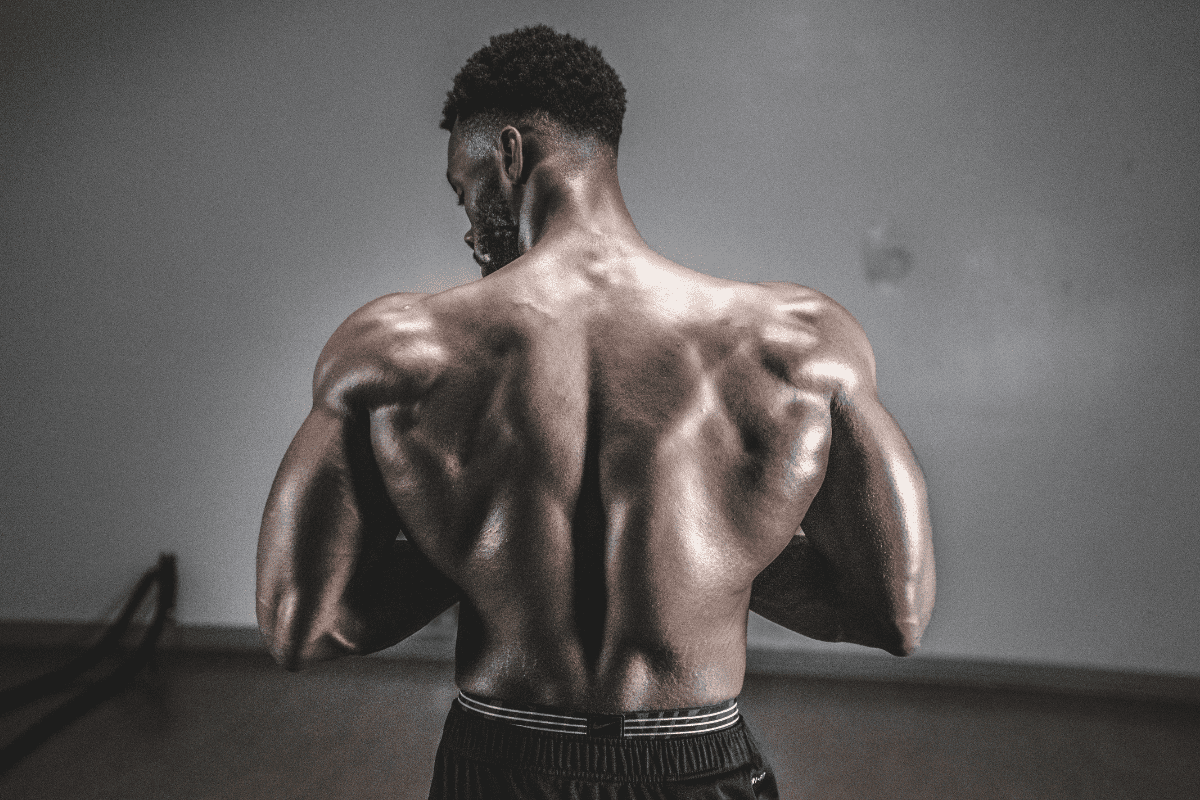10 Best Dumbbell Exercises for Traps to Build Strength
I’ve always been motivated by getting as strong as possible in the weight room – not aesthetics. But, my guilty pleasure has always been training traps. From the moment I got into strength training, I always wanted a giant set of traps sitting up on my shoulders.
If you’re looking to grow your traps and all you have to work with is dumbbells – no problem!
I’ve been a College Strength Coach for two decades and I’m going to share with you the 10 best dumbbell exercises to train traps. I’ll explain how to do each one, what their benefits are and a few coaching tips to help you maximize each one.
But, first, let’s do a really quick review of the trapezius muscle itself because I often get a lot of confusion about what it is and what it actually does.
Trapezius 101
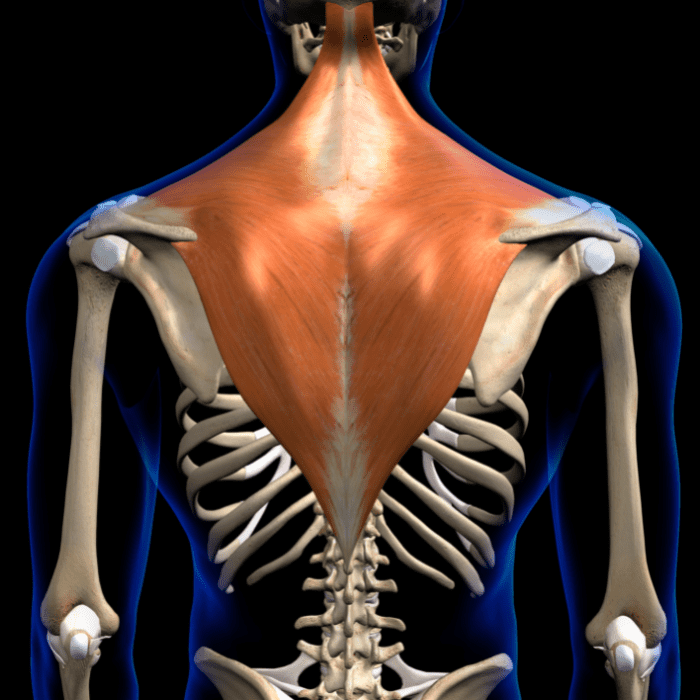
When a lot of people think about the trapezius muscle, aka the traps, what they actually think about is what is referred to as the upper traps. This is the part of the trapezius that essentially sits up on top of the shoulders. It’s what we’re working on when we (spoiler alert) Dumbbell Shrug.
However, the entire trapezius muscle is actually much bigger and has much more function than just shrugging our shoulders. There are also the medial and inferior parts or the trapezius that help with functions like rowing and retracting the shoulder blades.
So, yes, I’m going to give you exercises that focus on the upper traps (like shrugs), but I’m also going to give you some dumbbell trap exercises that work the other sections of the trapezius too.
Class dismissed. Let’s get started.
Dumbbell Shrug
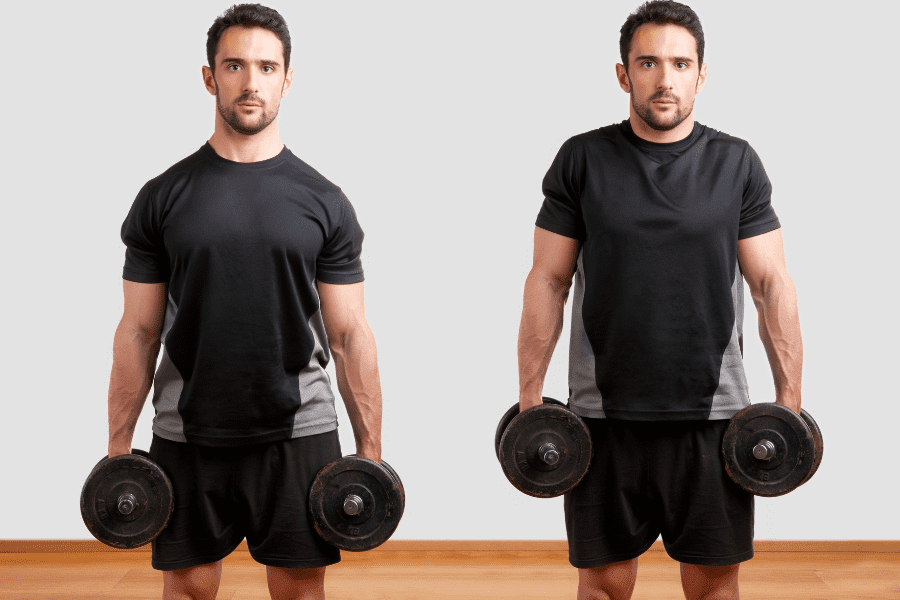
The Dumbbell Shrug is easily the king of dumbbell trap exercises. And, there’s a pretty good chance you’re already aware of shrugs and so you’re skipping right past this one.
But, just in case you’re not, the Dumbbell Shrug is the first place you should start if you want to build your upper traps with a pair of dumbbells.
Step-by-Step Instructions
- Grab a pair of dumbells, one in each hand
- Place feet hip-width apart, brace the core and stand tall
- Now shrug up, visualizing touching your traps to your ears.
- Do NOT ‘roll’ the shoulders. Shrug straight up and straight down.
- Keep good posture. Do not let the shoulders slouch forward during the set.
- Control the weight back down to the starting position.
Coaching Points
A Dumbbell Shrug already has a short range of motion. Don’t shorten the range of motion even further by grabbing more weight than you can properly lift. (A mistake I see quite often)
Finding a box or bench to rest the dumbbells on in between sets can be a gamechanger as opposed to lifting them off the ground each set.
Dumbbell Upright Row

Step-by-Step Instructions
- Grab two dumbbells and start with them at arm’s length in front of the thighs, palms toward the body.
- Flex knees slightly and stand upright with good posture.
- Pull the dumbbells upward along the abdomen and chest toward the chin.
- At the top, the elbow should be higher than the wrist, and above the shoulders.
- Lower the bar dumbbells and under control to the front of the thighs.
- Do not ‘jerk’ or ‘rock’ the weight up and keep the dumbbells close to the torso throughout.
Coaching Points
The biggest mistake I see, by far, with Dumbbell Upright Rows is swinging way too much to lift the weight.
A little swing is okay if you’re trying to grind out the last rep or two of a set, however, if you’re having to rock your torso for every rep then the weight is too heavy. Grab some lighter dumbbells and use proper form.
Dumbbell Side Raise
You may think of Side Raises as a shoulder exercise and you’re absolutely right. What you may be less aware of is Lateral Raises do a sneaky good job of working the traps as well.
Instructions
- Hold dumbbells-palm in, arms straight down at sides.
- Raise dumbbells in semicircular motion slightly above shoulder height tilting the head of the dumbbell down.
- A slight pause, then lower to starting position under control.
- Keep your arms straight with just a slight bend in the elbow.
Coaching Points
Always start the movement at the side of the thigh. Bringing the dumbbells in front of the body allows for more of a momentum swing and takes away from the stress placed on the delts.
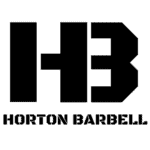
Tired of coming up with your own workouts? But don’t want to pay an arm and a leg?
I post workouts 5 days a week right here. (Did I mention they’re free?)
Farmer’s Walk
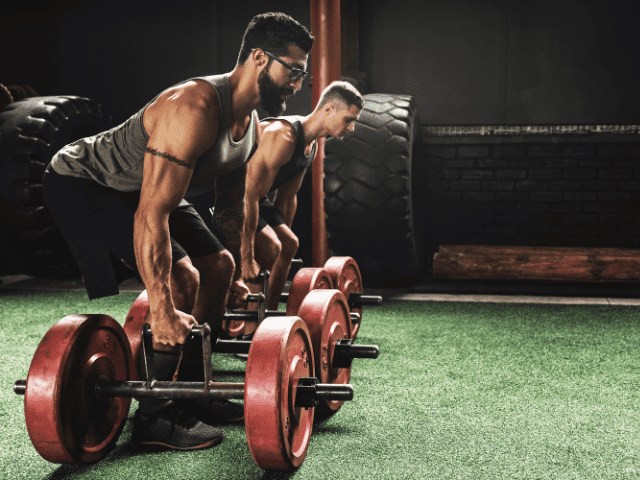
Step-By-Step Instructions
- With the dumbbells at your side, hinge at the waist and bend at the knee until you can pick them up. Remember to always lift with a nice flat back, neutral spine, and a tight core.
- Hold the kettlebells slightly away from your sides.
- Keep the core tight, shoulder blades back, and posture up tall.
- Walk with extreme control. Generally, I prescribe walking 20 yards out and 20 yards back for a set but longer distances are fine as long as the form remains intact.
- Focus on crushing the handles with your grip. Avoid any trunk deviation side to side or front to back. Try to walk as controlled as you possibly can.
Coaching Points
Choosing an appropriate weight is critical here. The focus is to keep the core tight and perfect posture. So if you go too heavy and your form deteriorates, you won’t get the full benefit of the exercise and may hurt yourself.
The single-arm variation is also an awesome challenge. Because the weight will be pulling your center of mass laterally, you will have to focus on resisting this lateral trunk flexion. I typically would program 20-yard walks with one arm and switch arms to return 20 yards.
Single Arm Snatch
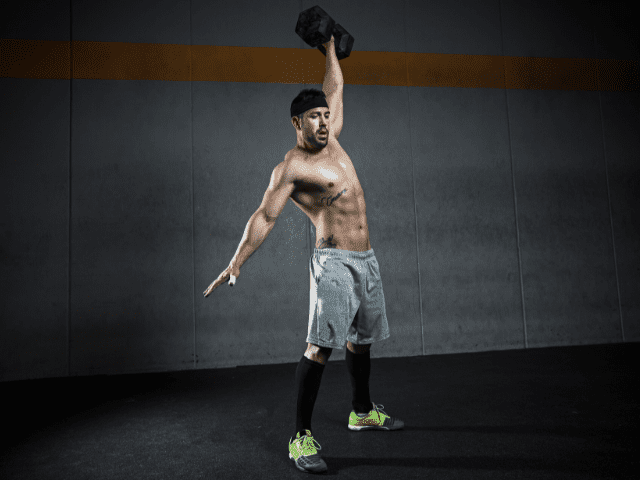
Step-by-Step Instructions
- Stand with feet shoulder-width apart, holding the dumbbell in one hand, positioned between your legs.
- Begin with a slight bend in the knees and hinge at the hips, lowering the dumbbell towards the ground.
- Powerfully extend your hips and knees, pulling the dumbbell upwards in a straight line.
- As the dumbbell ascends, begin to pull your elbow underneath it.
- Fully extend your arm overhead, catching the dumbbell in a locked-out position.
- Control the dumbbell back to the starting position, maintaining good posture.
Coaching Points
The two biggest mistakes that I see with Single Arm Snatches are not keeping the dumbbell close to the body on the way up and letting the dumbbell ‘yank’ the shoulder down as it comes back to the starting point.
Dumbbell Hang Power Clean
Instructions
- Stand with feet hip-width apart, holding the dumbbells in front of you with palms facing your thighs.
- Slightly bend your knees and hinge forward at the hips, lowering the dumbbells towards your knees.
- Swiftly extend your hips and knees, pulling the dumbbells upward by driving your elbows high.
- While the dumbbells are elevating, rotate your wrists under them and catch them at shoulder height, elbows pointing forward.
- Control the dumbbells back to the hanging position, maintaining a neutral spine.
Coaching Points
Make sure to maintain a neutral, flat back during the hinge. One of the biggest mistakes that can lead to an injury is allowing the back to round during the hinge or pull. This puts an excessive amount of strain on the spine as the athlete begins the movement.
Chest Supported Rows
Part of what makes Chest Supported Rows great is that you can easily adjust the angle of the bench which will adjust the amount of emphasis you can place on the medial or upper traps. A higher angle will hit more upper trap, and a lower angle will focus more on the medial portion.
How To
- Set up an adjustable bench at a 45-degree angle.
- Lay on your stomach with your head hanging just above the edge of the bench.
- Grab a dumbbell in each hand and set up with a good posture – core and lats engaged and shoulders neutral.
- Row the dumbbells toward the top of the stomach and squeeze the back at the top of the rep.
- Finally, lower the dumbbells back to the starting position.
Coaching Points
Make sure to maintain good posture through the movement. Oftentimes I see athletes who allow their shoulders to slouch forward and drape over the edges of the bench.
Dumbbell One Arm Row
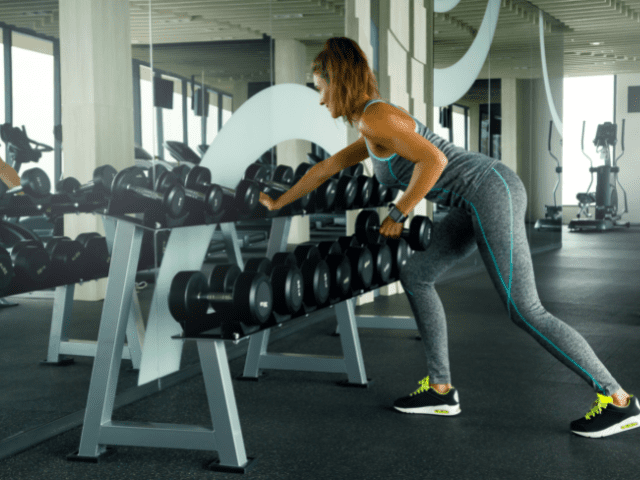
Step-by-Step Instructions
- Place the dumbbell next to the bench and set yourself up.
- If rowing with the right arm, place the left knee and left hand on the bench. Keep the right foot flat on the ground.
- Make sure the back is flat (neutral) to slightly arched.
- Brace the core and pick the dumbbell up.
- Row the dumbbell up, keeping the elbow close to the body as the dumbbell raises.
- Squeeze the back at the top of the rep and then lower the dumbbell down until the arm is fully extended.
Coaching Points
The most common mistake I see athletes make when doing One Arm Rows is not maintaining a flat back. The back should stay engaged and slightly arched – similar to the starting position of a Power Clean. Do not let the back round as this can cause unnecessary stress on the spine.
Also, do not twist and turn while rowing. You’re not starting a lawn mower. If you need to use your whole body to twist and rock the weight up then the dumbbell is too heavy. Lower the weight and maintain proper form.
Rear Delt Raise
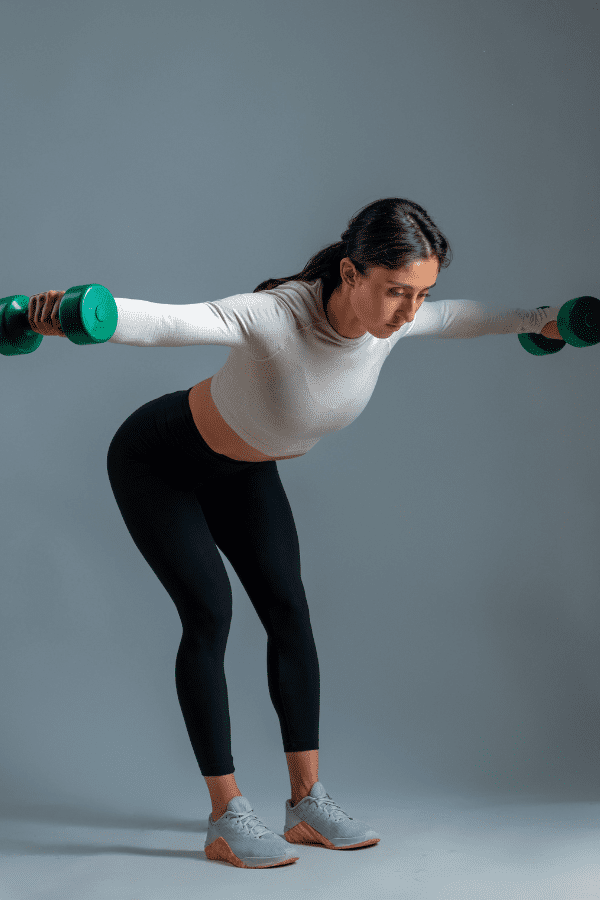
Step-by-Step Instruction
- Grab your dumbbells (or plates) and bend at the waist until you are close to perpendicular to the floor.
- I recommend slightly bending the elbow and keeping your palms facing each other. As you execute the movement, the palms will face the floor.
- Initiate the movement by bringing your arms out to the side and squeezing the shoulder blades.
- Pause at the top of the movement for about 1 second.
- Slowly lower your arms back to the starting position.
Coaching Points
In the setup for Rear Delt Raises, be sure to bend at the waist enough so that you are perpendicular as much as possible. In this movement, the burn should be felt in the upper back and rear shoulders. If your setup is too vertical, you may feel the burn in the traps or medial delts.
Dumbbell RDL
Dumbbell RDLs work the traps in a more isometric fashion as they’re responsible for maintaining posture during the movement. Don’t let that fool you though, Dumbbell RDLs can be very effective at developing upper back strength.
Step-by-Step Instruction
- Choose a pair of dumbbells and hold them in front of you with palms facing your thighs.
- Stand with your feet hip-width apart, maintaining a slight bend in the knees.
- Begin by hinging at your hips, pushing them backward, and lowering the dumbbells along your shins.
- Keep your back straight and chest up, ensuring the dumbbells stay close to your legs throughout the descent.
- Once you feel a stretch in your hamstrings or the dumbbells reach mid-shin level, reverse the motion.
- Engage your hamstrings and glutes to pull yourself back to the starting position.
Coaching Points
It is important for the lifter to maintain a neutral spine, maintaining tension in the abdomen and upper back. Remember to breathe in and hold the breath during eccentric (lowering the weight) and breathe out as you perform the concentric movement (bringing the weight back up).

Online Strength Programs
- 1-on-1 Online Coaching
- Sports Performance Programs for Football, Basketball, Soccer & More
- Programs for Former Athletes (Legends) Who Still Want to Train Like Athletes
- Programs for Adults Who Want to Get Healthy (and look great at the beach!)
- Use Code “HB10” to Get 10% Off Today
Final Thoughts
As you can see, dumbbells are more than enough to work your traps. And, not just your upper traps either, but the entire trapezius muscle.
Finally, if you came here looking for alternatives for Barbell Shrugs, you’re not limited to just dumbbells. Here are my favorite Barbell Shrug alternatives.

